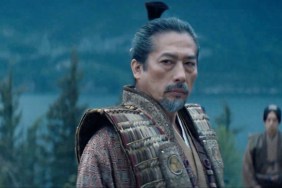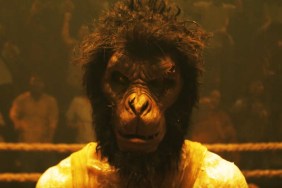Here at ComingSoon.net, we’ve always tried to spend equal time focusing on established filmmakers and talent as we do on up and comers, and when it comes to new directors who have really impressed us this year, one of the first names on our lips is that of Cary Joji Fukunaga, whose first feature film Sin Nombre premiered at the Sundance Film Festival, where it received awards for its direction and cinematography.
While on the surface, Sin Nombre might seem like “just another immigration movie,” it’s really a film that uses immigration as a backdrop to follow the journey of two teens through the violent world in which they live. Fukunaga’s debut is more about creating realism and depth in these characters and their situation than trying to jump on any political bandwagon, owing more to Joshua Marston’s Maria Full of Grace or Fernando Meirelles’ City of God than any of the other recent immigration movies.
The film follows Sayra (Paulina Gaitan), a Honduran teen traveling through Mexico with her father and uncle on their way to the United States, and Casper (Edgar Flores), a member of a notorious Mexican Mara Salvatrucha gang, a life he decides to leave behind when his leader Lil’ Mago (Tenoch Mejîa) does something despicable and unforgivable. A chance meeting of these three characters on a train traveling through the slums of Mexico leads to a fate that brings Casper and Sayra together as they’re pursued by local gangs.
The realism of the film’s characters and environment are even more amazing when you realize that Fukunaga used traditional filmmaking techniques to realize his vision, casting every role both from established local actors and non-actors, as well as creating most of the environments in a different area of the country rather than trying to film in the real places where these stories take place all the time.
ComingSoon.net sat down with Fukunaga to talk about the origins and obstacles involved with bringing his evocative coming-of-age “migration” story to life.
ComingSoon.net: I didn’t know much about this movie before seeing it, but it did almost appear out of nowhere. It was at Sundance and just days earlier, Focus announced that it would be released in March, but you must have been working on it for a long time under the radar.
Cary Joji Fukunaga: Focus got involved actually as of February 2006, so they’ve been involved for a while. I don’t know what their strategy was. Like you said, they hadn’t talked about it much. I remember when we were going into Sundance was kinda like, “Are we ever gonna get a website?” But they know what they’re doing, so it’s being talked about now I guess.
CS: Did they get interested in doing something with you after seeing your short film?
Fukunaga: Well, they knew about the short film. I’d already written the script by that point out of the Sundance Labs and out of the Sundance Labs is when they became involved.
CS: Anyone watching this movie and its Central-American cast would automatically assume it was made by a Mexican director, so what is your actual background and how did you get involved with telling this story?
Fukunaga: I’m not Mexican and I’m not Central American. I’m from California. My dad is from Japanese descent, my mom is from Swedish descent and through marriages and divorces, a pretty multicultural family, a lot of Spanish speakers in the family. I didn’t grow up wanting to do an immigration film. It’s just something I sort of fell into and through a series of events, I sort of became an accidental tourist in this world after making a short film and then ultimately writing a feature film that’s pretty far from my experience, my life. Through research, I was able to really immerse myself in it, so a lot of what I researched is on the screen.
CS: Now the stuff in your short film, was that of a similarly related topic and just a different angle on it? Were parts of it similar?
Fukunaga: It’s immigration, but it takes place in Texas and it’s about a trailer that was abandoned in Victoria, Texas. It’s called “Victoria para chino” and was on the iTunes site for a while, but it got an honorable mention at Sundance and went on to win about 24 national awards, a student Academy Award. I made that film ’cause I wanted to make a film about that subject, but it ended up starting my film career in a way that was unexpected and in a way I hadn’t really prepared for it. So it was an opportunity to start to prepare to make feature films and be represented and put myself out there as a film director. It was one of those situations where I was suddenly happy to do the work and take advantage of the moment, but that wasn’t the impulse behind it.
CS: The fact that you had the idea to do this and started writing the script about this subject matter as your first feature film is pretty ambitious.
Fukunaga: My ideas tend to be either really big in terms of like, the logistics, or really small. So it’s like, I have yet to figure out how to do that middle of the road, simple, two-character, one-character story, which I’m learning about right now as I’m writing my new script. But yeah, I’m always attracted to these grandiose ideas as someone who is really looking at what I was doing carefully as I was developing it, they would probably tell me that I was crazy and I should write something simple and more within my means, but I didn’t and I just wrote that.

CS: Can you talk about the research you did? You actually went down there and rode the train and put yourself in that environment which is kinda dangerous, but that’s also a lot of research to write a script.
Fukunaga: Because it’s not my culture and because it’s not my experience, I absolutely needed to do first-person research to really be able to write the characters and create the mood and then to eventually be able to recreate it as a director, so it was just total immersion. Everything I could do that’s related to the subject with the gangs and prisons and the train yards with immigrants and shelters and then also just riding the train with them and traveling with immigrants.
CS: How about the gang aspect of the movie? I’d imagine being in California, you must have some of it around you, but when you were down in Mexico, did you meet people involved in the gangs?
Fukunaga: As you can tell I’m not a gang member. Yeah, I’d grown up in the Bay Area, there were certain gangs around then. There were times when I lived in neighborhoods where there were gangs. I never lived inside of a house with a gang, so I didn’t really know how to function. Entering the gang, a lot of that was sort of like, what is the internal dynamics to get a feel for what it’s like? Again, with the goal to be able to recreate it authentically. I just didn’t want to do a cliché sort of like, version of hat the gang; I mean, everything would just be derivative. Gangs in and of themselves are sort of archetypes of themselves. They create this archetype and everyone lives up to that image, but, within the house I think there’s individual dynamics and I really wanted to get that right in the film and fill it with detail.
CS: When you were down there researching, how easy or hard was it for you to fit in? Did you try to create a character for yourself or did you go around with people who knew you were making a film and could help you get the research you needed?
Fukunaga: Well, two friends from the short film helped initially on research and one of those guys, Gabriel Nuncio, ended up translating the script. Nuncio is a friend of mine, he’s basically worked with me on every film. He was there when I made my first MOS, he was my AD and a producer when I made the short film and then he came out with me on the feature film and did an excellent job. He really spent a lot of time also just with me doing research and with the gangs. He didn’t want to ride the trains with me, so I did that by myself, but other than that, he was there.
CS: When you were down there the first time, did you meet people that inspired the two characters in the story you wanted to tell or did that come out of doing earlier research? Essentially, the movie is two stories about two specific characters who eventually are brought together.
Fukunaga: Right, it’s not your classic sort of three-act structure, but there were two stories that I wanted to tell and I found to combine them in a way that hopefully balances it out. There’s always a question, whose story is it? So I feel like there’s a tendency in film that it has to be one person’s story. I didn’t necessarily want it to be just one person’s story, but I wanted to try to make it as much their story as possible.
CS: Were any of the side characters inspired by the time you spent down there?
Fukunaga: Yeah, definitely. At least some of the events were through some of the research and hearing people’s stories about what happened when they were on the train. The attack scene was based on a guy in a shelter who told me about he was trying to protect a girl. They were trying to rape her and the gang attacked him and macheted him and chopped his head, almost cut his arm off and he barely survived because he fell off the train. But the girl’s character was just sort of inspired by the idea of a female on this journey. It’s so dangerous being a female and what it must be like for a young girl with all these men, and the girl with her father and what would she be like? I kind of liked the idea of dealing with the independent spirit. His story just sort of goes back to the Westerns in dealing with this sort of guy who was young and already tired of life in a weird way and wanting something different and the sort of quote-unquote, “killing of the father” to be able to start a new life.
CS: Those are amazing stories. Just getting the cast to do this because I think you always knew you were going to cast down there in Central America with a mix of experienced and inexperienced actors. This is really tough material for them. What was the process for finding somebody who could actually pull these roles off and deal with such tough subject matter?
Fukunaga: It was hard. One of my first conversations with Focus was about casting and about how movies can be ruined by casting. To make this film authentic I needed Central Americans and I needed people from the right social classes. You can’t have rich kids or upper middle class kids who want to be actors playing gangsters and make it seem real. So I think in some ways it was unorthodox casting. For some of the Mexican casting directors, it was hard for some of them to reconcile that. They kept sending me the same kind of groups of actors that are in every Mexican film or television show. I was just like, “No, no, no, no,” until there was none left and they’re just like, “Well, what do we do?” I’m like, “Street cast. Let’s find real people.” Casting directors, I don’t think, are the best in Mexico at street casting. Whereas I think in New York and in L.A., that’s more common, not so in Mexico. So it’s up to you as a director in a lot of ways to go out and do that.

CS: What about the guy who plays the main gang leader, Tenoch? Did he already have all those tattoos?
Fukunaga: No, it was all makeup.
CS: No way! Really?
Fukunaga: Yeah. Tenoch is from a working class neighborhood outside of Mexico City. He’s an awesome guy, good family, was like, the football captain, you know, like that kind of guy, team leader, naturally charismatic, and funny. That’s the kind of guy I wanted to play that role and then give him all of the edge of a violent…
CS: Wow, that’s insane. How many times did you have to do that tattoo job? Or did you just do it once?
Fukunaga: No, we had to wash that off every day. It’s too dangerous.
CS: Just being in that area with those tattoos?
Fukunaga: Yeah, it’s a real gang.
CS: So you actually had pictures of real gang members and copied their tattoos?
Fukunaga: We couldn’t copy it exactly, we had to interpret it. I think there’s weird liferights issues with that, so we had to interpret the tattoos and make them unique, or mix and match, but yeah, it’s all kinda based on real iconography.
CS: This movie’s getting more amazing the more I hear about what went into making it. Even with the train yards and the trains, filming all that stuff, this really feels like a big movie.
Fukunaga: What’s crazier is that I showed it to NYU, my school, and there was a kid there from Tapachula, where it takes place, and he thought the train yard was shot in Tapachula, and I said, “No, it wasn’t. It was shot in Mexico City.” So I was really happy to hear that someone from the place I was making this movie actually thought we shot in the real place. There were a couple of real characters, there was a transvestite that works in the train yard and I had her in there, an actor playing her. He’s like, “You know, that’s a real person in the train yard,” and I’m like, “Yes, I know. That’s why we put it in there.” So it’s great to hear, especially not being a native Spanish speaker, to have people feel like its authentic and that to me, there’s no greater compliment. I think than people from Latin American, from Central America, in Mexico, who would mistake the creators behind this film from being native.
CS: Was that train yard actually completely constructed?
Fukunaga: No, no, we did it in a train yard in Mexico City.
CS: As far as finding extras, you just had a lot of extras?
Fukunaga: Right, we had an extras casting director with an entire wall filled with Polaroids and I’d sit there and I’d pick out my close-to-camera groups and my far away from camera groups. I spent a lot of time on extras. I think that, Boris Frumin, who was a professor at NYU, really showed that extras can ruin your film. So you need to spend just as much time casting your extras as you do casting your leads.
CS: What did you do on your original trip? Did you have a camera to take pictures and capture what the place looked like?
Fukunaga: I made a whole visual reference book and I gave it to the studio and I hand-bound it. I think I was just bored waiting for a green light and I was trying to do something, so I started getting into book binding (laughs). So I printed out this book of images I’d taken through my two years of research and I sort of put it in chronological order so you get a very visual image of what this movie could look like when it’s done.
CS: Do you think you’ll get that published some day?
Fukunaga: Amy Kaufman, the producer, has mentioned it and actually Jane, who was the physical production executive, brought it up the other day. Who knows? I think it depends on if the film gains any sort of popular support then I think a book like that would make sense maybe just so people can get an idea of images.
CS: Even just for film students or people interested in that kind of thing. What about shooting on the train? I know some of this was shot on a real train and the rest on a constructed train, but it all seems very dangerous to me.
Fukunaga: I’ll tell you what; each one has its pluses and minus, but at least the construction one had pneumatic tires so if someone fell off, they’d either bang their head pretty bad or break a leg, but the tires wouldn’t cut the limb off.

CS: True, but how do you convince these actors, “Okay, we’re gonna go up on top of a train now”?
Fukunaga: By doing it first. I’ll be the first one to do whatever I’ll ask people to do. (laughs) But people thought I was crazy, they called me “El Gringo Loco” so it didn’t really help.
CS: Were they actually harnessed down to something?
Fukunaga: They were harnessed down. I never harnessed myself down.
CS: You’d already done it before.
Fukunaga: Yeah, I was like, “I’ve done the real thing guys.” But the Universal Studios safety guy came and Amy Kaufman’s like, “Can you please put on your harness today?” I was like, “Yeah, yeah, sure. I’ll put it on.” I’m so used to jumping between train cars and being the last person to duck for the branches, that an idea occurred to me and I wanted to go and talk to my cinematographer, so I jumped up and the harness like yanked me back and almost threw me off the train ’cause I was so used to not using the harness. I took the thing off and I told her, “I’m not wearing this again.” (Laughs)
CS: I’m really amazed that the people run these trains and own the trains allow these people to hitch a ride, so there must be someone paying them off to allow it.
Fukunaga: You know, it’s both, there are smuggling groups that pay off the train drivers and there are just independent people that travel on their own, but no one asks permission.
CS: I was really curious ’cause nothing seems like there’s a lot of money and commerce in immigration.
Fukunaga: There’s a whole micro-economy, which I don’t go into in the story. It’s like too much information, but yeah, there’s a whole micro-economy and a lot of people being paid off, a lot of payoffs and money trickles down.
CS: I like the fact that your movie doesn’t get political and just deals with the characters. It’s not really about immigration but it’s just set in that world.
Fukunaga: It was just the world that these characters deal with, just like what’s going on. That was the important part because I think once it becomes an issue film, then it’s dated and it exists just for that time and that’s it.
CS: Since you’ve been at the Sundance Lab, you must’ve known about all these other movies set in the world of immigration, which are obviously very different, being that they mostly deal with Mexicans coming into America. Did you try to avoid them and ignore they existed?
Fukunaga: I knew that no one was doing an immigration story like mine. All the other narrative stories kind of touch on immigration, no one was doing anything about the trains and the South, so I wasn’t too worried.
CS: Did you see any of them? I think all of them played at Sundance.
Fukunaga: Like documentaries and stuff?
CS: Not documentaries, but I think there was “Trade” and “Under the Same Moon” for instance.
Fukunaga: Yeah, but they’re so different from my film that I didn’t really worry about it too much. The girl (who gets kidnapped) from “Trade” is the same girl we have in the film; she was like 14 where she’s 18 or 17 on this one. I think she’d heard of “Trade” at that point. (Note: That was a joke.)
CS: You actually finished this movie sometime last year?
Fukunaga: Yeah, I did. December of last year.
CS: What have you been doing since then? Do you have more scripts you want to keep working on?
Fukunaga: Yeah, I mean, it took me a little while to get back into writing. I was in post-production for a while. I started making music for a little while. I was gonna give up and become a hip-hop artist just like…
CS: Just like Joaquin?
Fukunaga: Yeah, just kidding. (Laughs) But no, I was just playing around for fun. I wanted to be creative, but I did not want to write a movie for a while. But now I’m getting back into writing again and I got two deals with Focus and Universal, so now I have deadlines. I’m a good person with deadlines; if I don’t have deadlines I’m in this weird ether.
CS: Are people approaching you to direct other things? If nothing else, this movie is really impressive when you watch it and then realize what was involved with making it. You have to say, “This guy can direct a movie. We can give him anything.”
Fukunaga: I’m glad you said it, maybe you have some jobs for me. (Laughs)
CS: No, I’m serious. I would think that when people see this, they’d immediately think about scripts they can throw your way.
Fukunaga: I get stuff, but the reality is I think that the best scripts that are out there that aren’t your own scripts go to the A-list directors. So although there are projects that are thrown my way, I’m not getting offered the things I’d probably be interested in doing because I’m getting the stuff that everybody else is saying “no” to. So it’s kind of up to me to come up with my own script.
CS: All of those big directors have to start somewhere.
Fukunaga: They do, I know. I think that the mistake is to think that, “Just because we made one film, that we deserve the best.” Just like anything else, we gotta put our time in and prove that we can make good films and are good storytellers, so that’s the goal.
You don’t have to believe our hype. You can see Sin Nombre for yourself when it opens in select cities on Friday, March 20.









